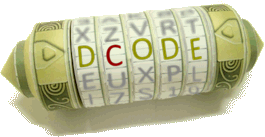Tool to generate/decode POSTNET barcodes. POSTNET (Postal Numeric Encoding Technique) is a barcode standard used in the United States for mail routing.
Barcode POSTNET - dCode
Tag(s) : Character Encoding, Image Processing
dCode is free and its tools are a valuable help in games, maths, geocaching, puzzles and problems to solve every day!
A suggestion ? a feedback ? a bug ? an idea ? Write to dCode!
Barcode POSTNET
Barcode POSTNET Generator
Barcode POSTNET Reader/Decoder
Answers to Questions (FAQ)
How to encrypt using Barcode POSTNET cipher?
The POSTNET Barcode format allows coding only numbers. It generally contains the ZIP postal code (5 digits) and sometimes 4 additional digits (ZIP+4) for the Delivery point (DP) which corresponds to an even more precise mail collection point.
Each digit is coded in 5 bits, represented by short or long bars. The POSTNET correspondence table is:
| 0 | 11000 | 1 | 00011 |
|---|---|---|---|
| 2 | 00101 | 3 | 00110 |
| 4 | 01001 | 5 | 01010 |
| 6 | 01100 | 7 | 10001 |
| 8 | 10010 | 9 | 10100 |
A complete POSTNET barcode begins and ends with a bit 1 (long line), it also includes a check digit before the final 1.
How to decrypt Barcode POSTNET cipher?
The decryption of the POSTNET Code consists of reading binary short (= 0) and long (= 1) bands and then translating them via the coding table.
Example: A message 1 00011 00101 00110 1 translates to 123
POSTNET checksum is missing in this example
How to calculate the checksum characters?
The POSTNET code uses a basic checksum: add all the digits and keep the digit of units $ N $. The checksum is $ 10 - N \mod 10 $.
Example: The number 678 has for sum of digits $ 6+7+8 = 21 $, the unit digit is $ 1 $. The checksum is $ 10 - 1 = 9 $.
How to recognize POSTNET Barcode?
The POSTNET barcode has a graphic form made up of long and short lines.
The POSTNET barcode has a variable length.
The POSTNET barcode begins and ends with a long line.
The binary reading of the POSTNET barcode has a length equal to 2 modulo 5 (because 2 bits 1 are added both the beginning and at the end and the remaining characters are on 5 bits).
Source code
dCode retains ownership of the "Barcode POSTNET" source code. Any algorithm for the "Barcode POSTNET" algorithm, applet or snippet or script (converter, solver, encryption / decryption, encoding / decoding, ciphering / deciphering, breaker, translator), or any "Barcode POSTNET" functions (calculate, convert, solve, decrypt / encrypt, decipher / cipher, decode / encode, translate) written in any informatic language (Python, Java, PHP, C#, Javascript, Matlab, etc.) or any database download or API access for "Barcode POSTNET" or any other element are not public (except explicit open source licence). Same with the download for offline use on PC, mobile, tablet, iPhone or Android app.
Reminder: dCode is an educational and teaching resource, accessible online for free and for everyone.
Cite dCode
The content of the page "Barcode POSTNET" and its results may be freely copied and reused, including for commercial purposes, provided that dCode.fr is cited as the source (Creative Commons CC-BY free distribution license).
Exporting the results is free and can be done simply by clicking on the export icons ⤓ (.csv or .txt format) or ⧉ (copy and paste).
To cite dCode.fr on another website, use the link:
In a scientific article or book, the recommended bibliographic citation is: Barcode POSTNET on dCode.fr [online website], retrieved on 2025-11-04,
